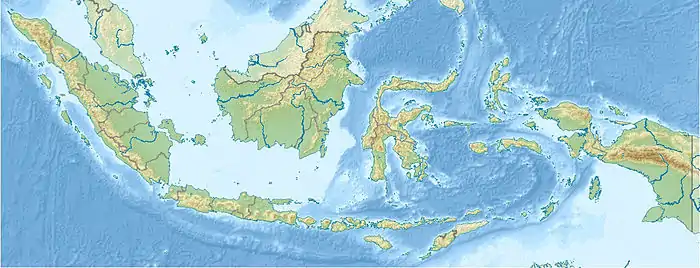Varanus yuwonoi
Varanus yuwonoi, also known commonly as the black-backed mangrove monitor, the black-backed monitor, and the tricolor monitor, is a species of monitor lizard in the family Varanidae. The species belongs to the V. doreanus species complex.[1][2] V. yuwonoi is endemic to the island of Halmahera, in the Maluku Islands, Indonesia.[3]
| Varanus yuwonoi | |
|---|---|
| Scientific classification | |
| Kingdom: | Animalia |
| Phylum: | Chordata |
| Class: | Reptilia |
| Order: | Squamata |
| Family: | Varanidae |
| Genus: | Varanus |
| Subgenus: | Euprepiosaurus |
| Species: | V. yuwonoi |
| Binomial name | |
| Varanus yuwonoi Harvey & Barker, 1998 | |
 | |
| Varanus yuwonoi is endemic to the island of Halmahera | |
Etymology
The specific epithet, yuwonoi, is in honour of Indonesian herpetologist Frank Bambang Yuwono (born 1958).[2][4]
Taxonomy
V. yuwonoi is a member of the V. doreanus species complex along with V. doreanus, V. finschi, and V. semotus.[1]
Description
The fully mature size of V. yuwonoi is currently unknown, owing to the great difficulty of observing this species. The largest individual recorded was 1.46 metres (4.79 feet) in total length (including tail) but was not fully grown.[5]
The species is strikingly colourful, with a bright blue tail and a yellow body. The tongue is also yellow, a shared characteristic of all monitors in the V. doreanus species complex.[6] The tail is heavily compressed and the teeth are proportionately very long compared to most monitors, even those which it is closely related to.[5]
Geographic range and habitat
V. yuwonoi is endemic to Halmahera Island, and is primarily found in its inland rainforest, where it is sympatric with V. caerulivirens, V. rainerguentheri, and possibly V. zugorum.[5]
Diet
V. yuwonoi is carnivorous. It frequents nest mounds excavated by megapodes, which attract smaller birds as well as small reptiles and insects that it may take as prey with its unusually long teeth. It may also consume megapode chicks and is reported to also excavate mounds to eat the eggs inside. This suggests that this species is specialized at ambushing birds.[5]
References
| Wikispecies has information related to Varanus yuwonoi. |
| Wikimedia Commons has media related to Varanus yuwonoi. |
- Weijola, Valter; Vahtera, Varpu; Lindqvist, Christer; Kraus, Fred (2019-07-23). "A molecular phylogeny for the Pacific monitor lizards (Varanus subgenus Euprepiosaurus) reveals a recent and rapid radiation with high levels of cryptic diversity". Zoological Journal of the Linnean Society. 186 (4): 1053–1066. doi:10.1093/zoolinnean/zlz002.
- Harvey, Michael B.; Barker, David G. (1998). "A new species of blue-tailed monitor lizard (genus Varanus) from Halmahera Island, Indonesia". Herpetologica. 54 (1): 34–44. JSTOR 3893395. (Varanus yuwonoi, new species).
- Varanus yuwonoi at the Reptarium.cz Reptile Database. Accessed 2 April 2020.
- Beolens, Bo; Watkins, Michael; Grayson, Michael (2011). The Eponym Dictionary of Reptiles. Baltimore: Johns Hopkins University Press. xiii + 296 pp. ISBN 978-1-4214-0135-5. (Varanus yuwonoi, p. 292).
- Weijola, Valter (2010-03-25). "Geographical distribution and habitat use of monitor lizards of the North Moluccas". Biawak. 4: 7–23.
- Weijola, Valter; Donnellan, Stephen C.; Lindqvist, Christer (2016-02-23). "A new blue-tailed monitor lizard (Reptilia, Squamata, Varanus) of the Varanus indicus group from Mussau Island, Papua New Guinea". ZooKeys (568): 129–154. doi:10.3897/zookeys.568.6872. PMC 4829673. PMID 27103877.